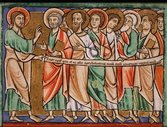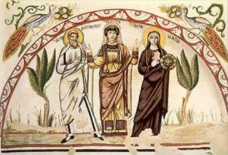Celebrating Sacred Time
The Lord himself, by word and example, gave the model for Christian prayer. In this illustration, he teaches the disciples to pray the Our Father. We know from one of the earliest Christian texts, the Didache, that three times a day the first Christian believers prayed the Our Father, and saw themselves as being united in this single act of prayer, made at the same time, even if they were physically separated. This is one of the most vital principles of Christian prayer - we can pray together with others and be united by time, even if separated by distance and this creates a unifying spiritual bond. We see this in the Old Testament in passages such as 1 Kings 18:36 and Judith 9:1.
And here in a fresco from the catacombs, we see early Christians making their prayer. During the first three centuries, Christianity was not a recognised religion, and Christians were always in danger of persecution. They were not allowed to gather together in public so they met secretly in the catacombs to pray. Prayer at morning and evening was seen as especially important because the Old Testament had prescribed sacrifice in the Temple at those times.
By the beginning of the fourth century, the church experienced a new- found freedom with regard to worship and all aspects of her public life after the Peace of Constantine in 312. Now Christians could worship openly and did not need to hide in the catacombs. This is an aristocratic Egyptian lady called Theodosia, depicted at prayer in the presence of two local saints. Her richly decorated garments show that she was a wealthy woman.



